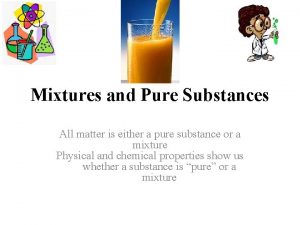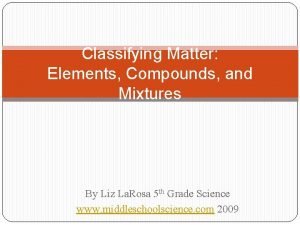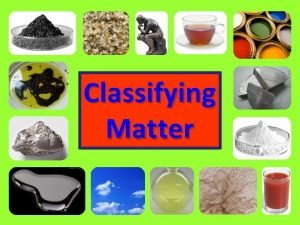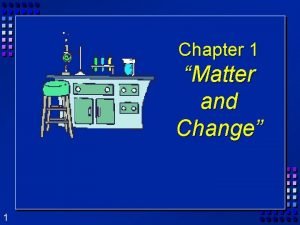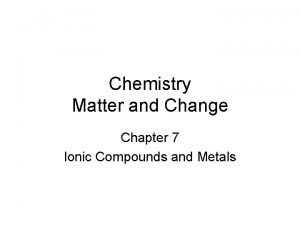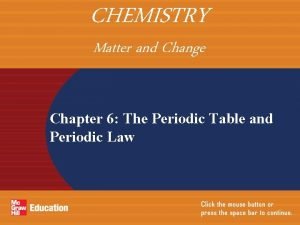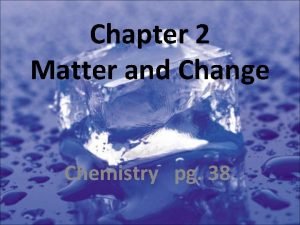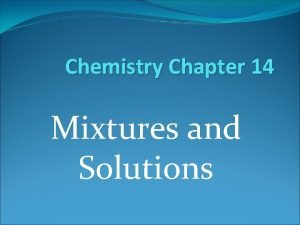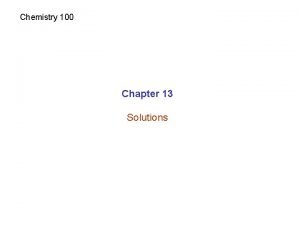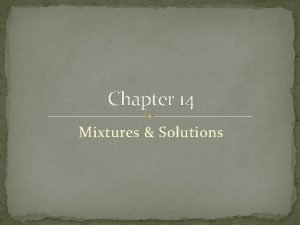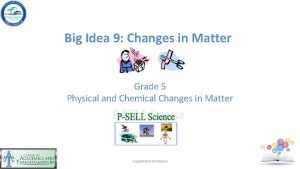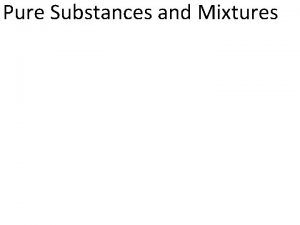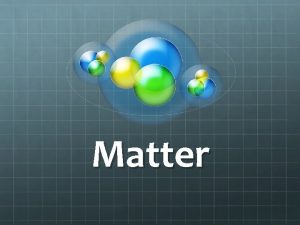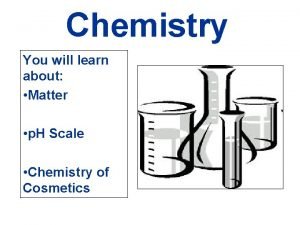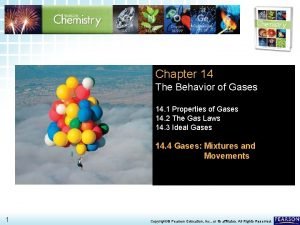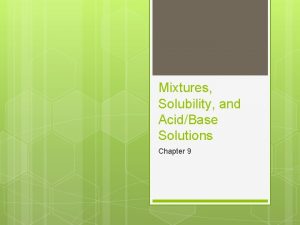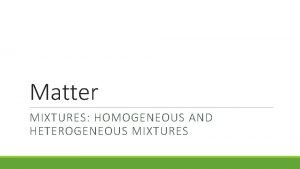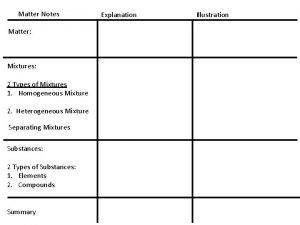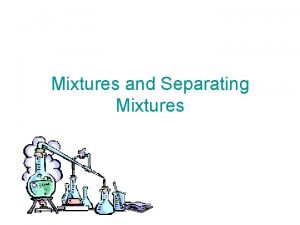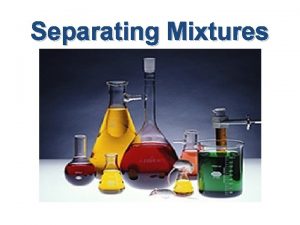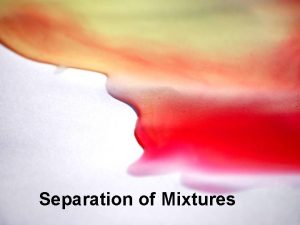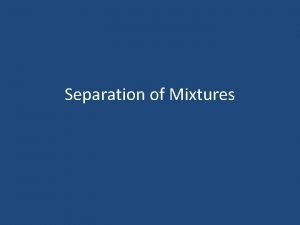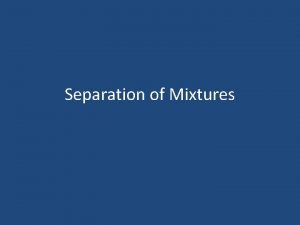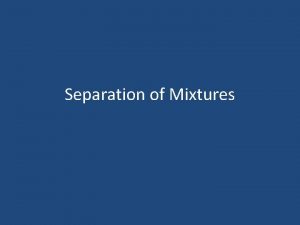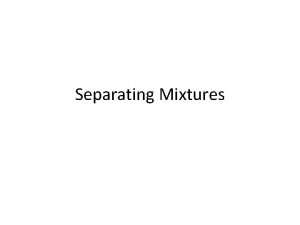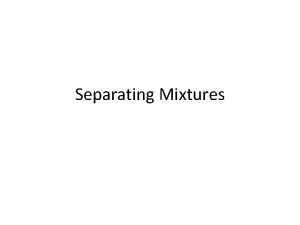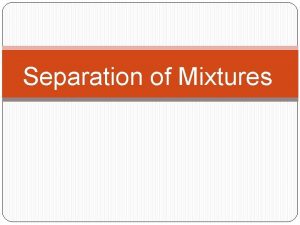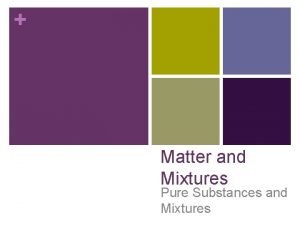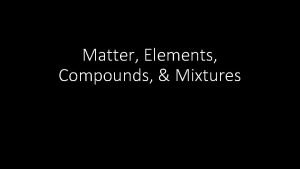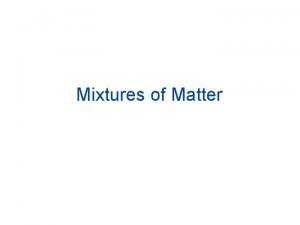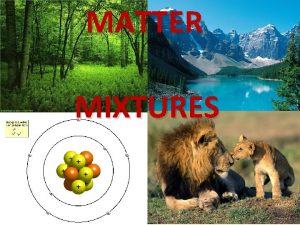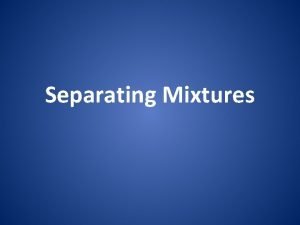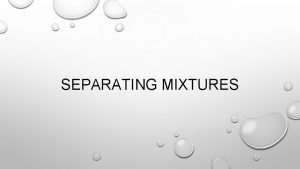2 2 Mixtures Chapter 2 Matter and Change












































- Slides: 44

2. 2 Mixtures > Chapter 2 Matter and Change 2. 1 Properties of Matter 2. 2 Mixtures 2. 3 Elements and Compounds 2. 4 Chemical Reactions 1 Copyright © Pearson Education, Inc. , or its affiliates. All Rights Reserved.

2. 2 Mixtures > Why aren't there coffee grounds in a cup of coffee? Coffee is often brewed by mixing hot water with ground coffee beans. 2 Copyright © Pearson Education, Inc. , or its affiliates. All Rights Reserved.

2. 2 Mixtures > Describing Matter How can mixtures be classified? 3 Copyright © Pearson Education, Inc. , or its affiliates. All Rights Reserved.

2. 2 Mixtures > Describing Matter • A salad bar provides a range of items, such as lettuce, tomatoes, cheese, and green peppers. • Customers choose which items to use in their salads and how much of each item to use. • So, each salad mixture has different types and amounts of components. – A mixture is a physical blend of two or more components. 4 Copyright © Pearson Education, Inc. , or its affiliates. All Rights Reserved.

2. 2 Mixtures > Describing Matter Most samples of matter are mixtures. • Some mixtures are easier to recognize than others. • You can easily recognize chicken noodle soup as a mixture of chicken, noodles, and broth. 5 Copyright © Pearson Education, Inc. , or its affiliates. All Rights Reserved.

2. 2 Mixtures > Describing Matter Recognizing air as a mixture of gases is more difficult. • But the fact that air can be drier or more humid shows that the amount of one component of air—water vapor—can vary. 6 Copyright © Pearson Education, Inc. , or its affiliates. All Rights Reserved.

2. 2 Mixtures > Describing Matter Based on the distribution of their components, mixtures can be classified as heterogeneous mixtures or homogeneous mixtures. 7 Copyright © Pearson Education, Inc. , or its affiliates. All Rights Reserved.

2. 2 Mixtures > Describing Matter Heterogeneous Mixtures In chicken noodle soup, the ingredients in the soup are not evenly distributed throughout the mixture. • There is likely to be different amounts of chicken and noodles in each spoonful. 8 Copyright © Pearson Education, Inc. , or its affiliates. All Rights Reserved.

2. 2 Mixtures > Describing Matter Heterogeneous Mixtures A mixture in which the composition is not uniform throughout is a heterogeneous mixture. 9 Copyright © Pearson Education, Inc. , or its affiliates. All Rights Reserved.

2. 2 Mixtures > Describing Matter Homogeneous Mixtures The substances in the olive oil are evenly distributed throughout the mixture. • So, olive oil doesn’t look like a mixture. 10 Copyright © Pearson Education, Inc. , or its affiliates. All Rights Reserved.

2. 2 Mixtures > Describing Matter Homogeneous Mixtures The same is true for vinegar. • Vinegar is a mixture of water and acetic acid, which dissolves in the water. 11 Copyright © Pearson Education, Inc. , or its affiliates. All Rights Reserved.

2. 2 Mixtures > Describing Matter Homogeneous Mixtures Olive oil and vinegar are homogeneous mixtures. • A homogeneous mixture is a mixture in which the composition is uniform throughout. 12 Copyright © Pearson Education, Inc. , or its affiliates. All Rights Reserved.

2. 2 Mixtures > Describing Matter Homogeneous Mixtures Olive oil and vinegar are homogeneous mixtures. • A homogeneous mixture is a mixture in which the composition is uniform throughout. • Another name for a homogeneous mixture is a solution. 13 Copyright © Pearson Education, Inc. , or its affiliates. All Rights Reserved.

2. 2 Mixtures > Describing Matter Homogeneous Mixtures Many solutions are liquids. • But some are gases, like air. • And some are solids, like stainless steel, which is a mixture of iron, chromium, and nickel. 14 Copyright © Pearson Education, Inc. , or its affiliates. All Rights Reserved.

2. 2 Mixtures > Describing Matter Homogeneous Mixtures The term phase is used to describe any part of a sample with uniform composition and properties. • By definition, a homogeneous mixture consists of a single phase. 15 Copyright © Pearson Education, Inc. , or its affiliates. All Rights Reserved.

2. 2 Mixtures > Describing Matter A heterogeneous mixture consists of two or more phases. • When oil and vinegar are mixed, they form a heterogeneous mixture with two layers, or phases. • The oil phase floats on the water, or vinegar, phase. 16 Copyright © Pearson Education, Inc. , or its affiliates. All Rights Reserved.

2. 2 Mixtures > At the beach, you realize that both ocean water and sand are mixtures. Which is a homogeneous mixture (or solution)? Which is a heterogeneous mixture? 17 Copyright © Pearson Education, Inc. , or its affiliates. All Rights Reserved.

2. 2 Mixtures > At the beach, you realize that both ocean water and sand are mixtures. Which is a homogeneous mixture (or solution)? Which is a heterogeneous mixture? Salt water is a homogeneous mixture, or solution. Sand is a heterogeneous mixture. 18 Copyright © Pearson Education, Inc. , or its affiliates. All Rights Reserved.

2. 2 Mixtures > Separating Mixtures How can mixtures be separated? 19 Copyright © Pearson Education, Inc. , or its affiliates. All Rights Reserved.

2. 2 Mixtures > Separating Mixtures If you have a salad containing an ingredient you don't like, you can remove it with a fork. • Many mixtures are not as easy to separate. 20 Copyright © Pearson Education, Inc. , or its affiliates. All Rights Reserved.

2. 2 Mixtures > Separating Mixtures • To separate a mixture of olive oil and vinegar, for example, you could decant, or pour off, the oil layer. • Or, you might cool the mixture until the oil turned solid. 21 Copyright © Pearson Education, Inc. , or its affiliates. All Rights Reserved.

2. 2 Mixtures > Separating Mixtures • To separate a mixture of olive oil and vinegar, for example, you could decant, or pour off, the oil layer. • Or, you might cool the mixture until the oil turned solid. – Pouring off the oil layer takes advantage of the fact that oil floats on water. – Cooling until the oil layer turns solid takes advantage of a difference in the temperatures at which the olive oil and vinegar freeze. 22 Copyright © Pearson Education, Inc. , or its affiliates. All Rights Reserved.

2. 2 Mixtures > Separating Mixtures Differences in physical properties can be used to separate mixtures. 23 Copyright © Pearson Education, Inc. , or its affiliates. All Rights Reserved.

2. 2 Mixtures > Separating Mixtures Filtration The coffee filter at right can separate ground coffee beans from brewed coffee. • The liquid brewed coffee passes through the paper filter, but the solid coffee grounds cannot pass through the filter. 24 Copyright © Pearson Education, Inc. , or its affiliates. All Rights Reserved.

2. 2 Mixtures > Separating Mixtures Filtration Filter paper used in a laboratory is similar to coffee filters. • Filter paper is often placed in a funnel. • Then the mixture is poured into the funnel. • Solid particles that cannot pass through the filter remain in the funnel. • The rest of the particles pass through. 25 Copyright © Pearson Education, Inc. , or its affiliates. All Rights Reserved.

2. 2 Mixtures > Separating Mixtures Filtration The process that separates a solid from a liquid in a heterogeneous mixture is called filtration. 26 Copyright © Pearson Education, Inc. , or its affiliates. All Rights Reserved.

2. 2 Mixtures > CHEMISTRY & YOU Brewed coffee is a mixture of ground coffee beans and water. What process is used to separate ground coffee beans from brewed coffee? 27 Copyright © Pearson Education, Inc. , or its affiliates. All Rights Reserved.

2. 2 Mixtures > CHEMISTRY & YOU Brewed coffee is a mixture of ground coffee beans and water. What process is used to separate ground coffee beans from brewed coffee? Filtration is used to separate ground coffee beans from brewed coffee. 28 Copyright © Pearson Education, Inc. , or its affiliates. All Rights Reserved.

2. 2 Mixtures > Separating Mixtures Distillation Tap water is a homogeneous mixture of water and substances that are dissolved in the water. • One way to separate water from the other components in tap water is through a process called distillation. 29 Copyright © Pearson Education, Inc. , or its affiliates. All Rights Reserved.

2. 2 Mixtures > Separating Mixtures Distillation During a distillation, a liquid is boiled to produce a vapor that is then condensed into a liquid. 30 Copyright © Pearson Education, Inc. , or its affiliates. All Rights Reserved.

2. 2 Mixtures > Separating Mixtures Distillation The figure below shows an apparatus used to perform a small-scale distillation. 31 Copyright © Pearson Education, Inc. , or its affiliates. All Rights Reserved.

2. 2 Mixtures > Separating Mixtures As water in the distillation flask is heated, water vapor forms, rises in the flask, and passes into a glass tube in the condenser. • The tube is surrounded by cold water, which cools the vapor to a temperature at which it turns back into a liquid. 32 Copyright © Pearson Education, Inc. , or its affiliates. All Rights Reserved.

2. 2 Mixtures > Separating Mixtures Distillation • The liquid water is collected in a second flask. 33 Copyright © Pearson Education, Inc. , or its affiliates. All Rights Reserved.

2. 2 Mixtures > Separating Mixtures The solid substances that were dissolved in the water remain in the distillation flask. • This is because their boiling points are much higher than the boiling point of water. 34 Copyright © Pearson Education, Inc. , or its affiliates. All Rights Reserved.

2. 2 Mixtures > Sample Problem 2. 1 Separating a Heterogeneous Mixture How could a mixture of aluminum nails and iron nails be separated? 35 Copyright © Pearson Education, Inc. , or its affiliates. All Rights Reserved.

2. 2 Mixtures > Sample Problem 2. 1 1 Analyze Identify the relevant concepts. In order to identify how to separate aluminum and iron nails, the properties of both aluminum and iron must be known. 36 Copyright © Pearson Education, Inc. , or its affiliates. All Rights Reserved.

2. 2 Mixtures > Sample Problem 2. 1 2 Solve Apply concepts to this situation. List the properties of each substance in the mixture. Aluminum • metal • gray color • doesn’t dissolve in water • not attracted to magnet 37 Iron • metal • gray color • doesn’t dissolve in water • attracted to magnet Copyright © Pearson Education, Inc. , or its affiliates. All Rights Reserved.

2. 2 Mixtures > Sample Problem 2. 1 2 Solve Apply concepts to this situation. Identify a property that can be used to separate different substances from each other. • The ability to be attracted by a magnet is a property that iron and aluminum do not share. 38 • You could use a magnet to remove the iron nails from a mixture of iron and aluminum. Copyright © Pearson Education, Inc. , or its affiliates. All Rights Reserved.

2. 2 Mixtures > Which physical property does filtration rely on to separate mixtures? Which does distillation rely on? 39 Copyright © Pearson Education, Inc. , or its affiliates. All Rights Reserved.

2. 2 Mixtures > Which physical property does filtration rely on to separate mixtures? Which does distillation rely on? Filtration relies on the size of a particle, or molecule, of a substance. Distillation relies on the boiling point of the substance. 40 Copyright © Pearson Education, Inc. , or its affiliates. All Rights Reserved.

2. 2 Mixtures > Key Concepts Mixtures can be classified as heterogeneous mixtures or as homogeneous mixtures, based on the distribution of their components. Differences in physical properties can be used to separate mixtures. 41 Copyright © Pearson Education, Inc. , or its affiliates. All Rights Reserved.

2. 2 Mixtures > Glossary Terms • mixture: a physical blend of two or more substances that are not chemically combined • heterogeneous mixture: a mixture that is not uniform in composition; components are not evenly distributed throughout the mixture • homogeneous mixture: a mixture that is uniform in composition; components are evenly distributed and not easily distinguished • solution: a homogeneous mixture; consists of solutes dissolved in a solvent 42 Copyright © Pearson Education, Inc. , or its affiliates. All Rights Reserved.

2. 2 Mixtures > Glossary Terms • phase: any part of a sample with uniform composition and properties • filtration: a process that separates a solid from the liquid in a heterogeneous mixture • distillation: a process used to separate components of a mixture using differences in boiling points 43 Copyright © Pearson Education, Inc. , or its affiliates. All Rights Reserved.

2. 2 Mixtures > END OF 2. 2 44 Copyright © Pearson Education, Inc. , or its affiliates. All Rights Reserved.
 What is mechanical mixtures
What is mechanical mixtures Types of matter elements compounds and mixtures
Types of matter elements compounds and mixtures Matter is classified as a
Matter is classified as a Chapter 2 section 1 classifying matter answer key
Chapter 2 section 1 classifying matter answer key Chemistry matter and change chapter 7
Chemistry matter and change chapter 7 Chapter 10 chemistry study guide
Chapter 10 chemistry study guide Chapter 1 review matter and change
Chapter 1 review matter and change Chemistry matter and change chapter 7
Chemistry matter and change chapter 7 Chemistry matter and change chapter 6
Chemistry matter and change chapter 6 Chapter 10 study guide the mole
Chapter 10 study guide the mole 2 matter and change answer key
2 matter and change answer key Chapter 1 matter and change worksheet answers
Chapter 1 matter and change worksheet answers What is white matter made of
What is white matter made of Dural septa
Dural septa Gray matter and white matter
Gray matter and white matter Matter
Matter Chapter 14 mixtures and solutions answer key
Chapter 14 mixtures and solutions answer key Chapter 13 solutions chemistry
Chapter 13 solutions chemistry Chapter 14 mixtures and solutions
Chapter 14 mixtures and solutions Classification of matter section 1 composition of matter
Classification of matter section 1 composition of matter Classification of matter section 1 composition of matter
Classification of matter section 1 composition of matter Composition of matter section 1
Composition of matter section 1 Flow energy review
Flow energy review Which is a big idea for matter and change
Which is a big idea for matter and change Unit 2 matter and change
Unit 2 matter and change Example of a solution mixture
Example of a solution mixture Change of state of matter
Change of state of matter Two types of changes in matter
Two types of changes in matter Physical change chemistry
Physical change chemistry Absolute change and relative change formula
Absolute change and relative change formula Difference between physical and chemical change
Difference between physical and chemical change Change in supply and change in quantity supplied
Change in supply and change in quantity supplied Chemical change and physical change
Chemical change and physical change Rocks change due to temperature and pressure change
Rocks change due to temperature and pressure change Whats the difference between chemical and physical change
Whats the difference between chemical and physical change First and second order change
First and second order change Compounds mixtures and elements worksheet
Compounds mixtures and elements worksheet Elements compounds and mixtures worksheet
Elements compounds and mixtures worksheet How do you classify uniform and non-uniform mixtures?
How do you classify uniform and non-uniform mixtures? Convenience utensils
Convenience utensils What is mixture in science grade 7
What is mixture in science grade 7 Mixtures of organic substances and a medicinal agent are:
Mixtures of organic substances and a medicinal agent are: 14.4 gases: mixtures and movements answers
14.4 gases: mixtures and movements answers Mixtures solubility and acid/base solutions answer key
Mixtures solubility and acid/base solutions answer key Composition of matter flow chart
Composition of matter flow chart
